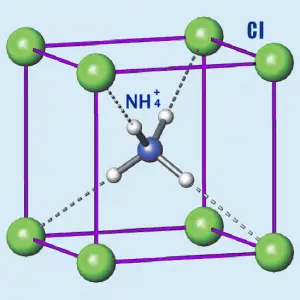Is Nh4cl Ionic Or Covalent
Why is NH4Cl ionic?
 Why is NH4Cl ionic?
Why is NH4Cl ionic?
Ammonium chloride (NH4Cl), in its outward advent is like a pure white crystalline salt only made out of ammonia and are highly soluble in water. It is too known in other names as Sal ammoniac which is a natural mineral structure of ammonium chloride. Sal ammoniac can exist seen on dumps of called-for coals or most commonly in volcanic areas shaping up on volcanic rocks that are near fume releasing vents.
Ammonium chloride is also produced commercially equally a product of a chemical reaction betwixt ammonia (NH3) and hydrogen chloride (HCl). This process can be seen when test tubes – or other containers with nonreactive materials similar glass, PVC, enamel and lead – containing ammonia solution and hydrochloric acid are brought closer together, it then creates a smoke that slowly ascent out of the tubes containing micro crystals of ammonium chloride.
NH4Cl is formed through ionic bonding. Ionic bond is a kind of chemical bond that is formed through electrostatic attraction connecting two ions with opposite charges or between a cation and anion. While Chlorine (Cl- that is an anion) lacks a unmarried electron to complete its valence shell, ammonium (NH4+ that is a cation) provides the missing electron that the chlorine needed and forms an ionic bond between the two.
In a style, NH4Cl is not formed through a pure ionic bail this is because NH4+ is a production of a covalent bond existing in the ammonium ion between the atoms of nitrogen (Due north) and hydrogen (H), in addition to the existing one coordinate covalent bond which is formed between one hydrogen atom and nitrogen. However, nitrogen still has an outstanding single electron that is transferred to the chlorine (Cl) thus resulting to an ionic bond. In this notion, ionic bond is the transference of electrons to connect with different atoms, while covalent bond is the sharing of electrons.
Writer: khristine
Is Nh4cl Ionic Or Covalent,
Source: https://www.knowswhy.com/why-is-nh4cl-ionic/
Posted by: jeffreycomman99.blogspot.com


0 Response to "Is Nh4cl Ionic Or Covalent"
Post a Comment